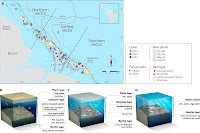Eelpout, Zoarcidae., are bottom-dwelling Eel-like marine fish related to Sticklebacks and Scorpionfish. Members of the genus Pachycara are found at bathyal to abyssal depths (between one and six kilometers below the surface of the sea) in all oceans
except the Arctic. There are currently twenty seven described
species, of which three have been described from hydrothermal vent
fields, areas where superheated water laden with minerals that has percolated through hot volcanic rocks reaches the surface, supporting
whole ecosystems that get their energy from chemotrophic Bacteria
(Bacteria that gain energy by breaking down chemicals from the vents
rather than photosynthesis).
In a
paper published in the journal Zootaxa on 13 January 2016, Eric Anderson of the South African Institute for Aquatic Biodiversity,
Russell Somerville of Ocean and Earth Science at the University ofSouthampton and Jonathan Copely also of Ocean and Earth Science at
the University of Southampton and of the Natural History Museum,
describe a new species of Pachycara from the Von Damm Vent Field on the
Mid-Cayman Spreading Centre and an un-named methane seep (area where
methane is escaping from sedimentary rocks on the sea-floor, also
often supporting ecosystems based upon chemotrophic Bacteria) close
to Tobago.
The
new species is named Pachycara caribbaeum,
in reference to the area where it was found. The species is described
from two male and one female specimens recovered from the Von Damm
Vent Field at depths of 2309-2313 m by deep-sea submersibles, none of
which are judged to be mature. The males are 117 and 199 mm in
length, the female 197 mm.
Pachycara caribbaeum
in the Von Damm Vent Field. Anderson et al.
(2016).
Pachycara caribbaeum
was found close to areas of
visible diffuse flow venting in the Von Damm Vent Field, with
temperatures ranging from 5-20ºC
with several potential prey species in the vicinity. This suggests
that the species does not have the tolerance of high temperatures
seen in some vent-dwelling organisms and avoids areas of higher
temperatures. He species was also observed at a methane seep close to
Tobago, though the individuals seen here were not as large or as
numerous as those seen in the Von Damm Vent Field, suggesting this
was a less optimal environment. The species has not been seen on the
roughly 2000 km of seafloor that separates the two sites, nor in the
Beebe Vent Field which lies close to the Von Damm Vent Field (about
30 km) away, but much deeper (about 5 km compared to the 2.3 km depth
at the Von Damm Vent Field.
Locations
(indicated by stars) of Pachycara
caribbaeu;
West, Von Damm Vent Field (depth ca.2300 m), east, methane seep near
Tobago (depth 1049 m). Scale bar is 1000 km. Anderson et
al.
(2016).
See
also...
 Extensive reef system discovered around the Amazon River Delta. Reefs, carbonate platforms created by the actions of benthic marine
organisms, are considered to be among the most important and biodiverse
marine environments, and in addition serve as important...
Extensive reef system discovered around the Amazon River Delta. Reefs, carbonate platforms created by the actions of benthic marine
organisms, are considered to be among the most important and biodiverse
marine environments, and in addition serve as important... Mollisquama sp.: A Pocket Shark from the Gulf of Mexico. In 1984 the Russian ichthyologist Vladamir Dolganov described an unusual
Dalatid Shark (the group which also includes Cookie Cutter Sharks,
Kitefin Sharks...
Mollisquama sp.: A Pocket Shark from the Gulf of Mexico. In 1984 the Russian ichthyologist Vladamir Dolganov described an unusual
Dalatid Shark (the group which also includes Cookie Cutter Sharks,
Kitefin Sharks... Cephalodasys interinsularis: A new species of Gastrotrich from the Bahamas. Gastrotrichs are a phylum of minute animals, generally less than a
millimetre in length, found in interstitial spaces in sediments (a phylum is
the...
Cephalodasys interinsularis: A new species of Gastrotrich from the Bahamas. Gastrotrichs are a phylum of minute animals, generally less than a
millimetre in length, found in interstitial spaces in sediments (a phylum is
the...
Follow Sciency Thoughts on
Facebook.


